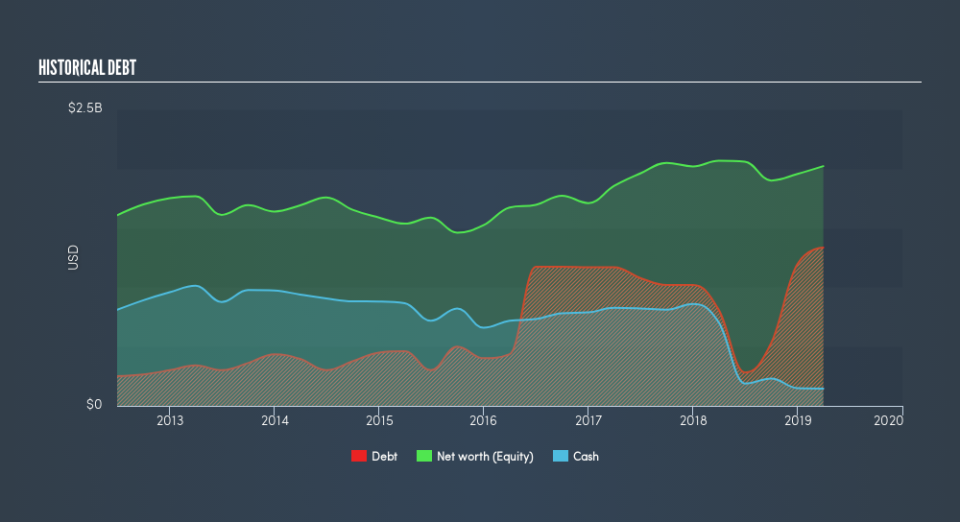What does ResMed Inc.'s (NYSE:RMD) Balance Sheet Tell Us About Its Future?

Want to participate in a short research study? Help shape the future of investing tools and you could win a $250 gift card!
Investors seeking to preserve capital in a volatile environment might consider large-cap stocks such as ResMed Inc. (NYSE:RMD) a safer option. Big corporations are much sought after by risk-averse investors who find diversified revenue streams and strong capital returns attractive. However, the health of the financials determines whether the company continues to succeed. I will provide an overview of ResMed’s financial liquidity and leverage to give you an idea of ResMed’s position to take advantage of potential acquisitions or comfortably endure future downturns. Remember this is a very top-level look that focuses exclusively on financial health, so I recommend a deeper analysis into RMD here.
See our latest analysis for ResMed
Does RMD Produce Much Cash Relative To Its Debt?
RMD has built up its total debt levels in the last twelve months, from US$810m to US$1.3b – this includes long-term debt. With this growth in debt, the current cash and short-term investment levels stands at US$147m , ready to be used for running the business. Moreover, RMD has produced US$447m in operating cash flow in the last twelve months, resulting in an operating cash to total debt ratio of 33%, signalling that RMD’s operating cash is sufficient to cover its debt.
Does RMD’s liquid assets cover its short-term commitments?
Looking at RMD’s US$463m in current liabilities, it appears that the company has been able to meet these obligations given the level of current assets of US$1.1b, with a current ratio of 2.38x. The current ratio is calculated by dividing current assets by current liabilities. Usually, for Medical Equipment companies, this is a suitable ratio since there is a bit of a cash buffer without leaving too much capital in a low-return environment.
Is RMD’s debt level acceptable?
RMD is a relatively highly levered company with a debt-to-equity of 66%. This is common amongst large-cap companies because debt can often be a less expensive alternative to equity due to tax deductibility of interest payments. Consequently, larger-cap organisations tend to enjoy lower cost of capital as a result of easily attained financing, providing an advantage over smaller companies. We can check to see whether RMD is able to meet its debt obligations by looking at the net interest coverage ratio. Net interest should be covered by earnings before interest and tax (EBIT) by at least three times to be safe. In RMD's case, the ratio of 25.38x suggests that interest is amply covered. High interest coverage serves as an indication of the safety of a company, which highlights why many large organisations like RMD are considered a risk-averse investment.
Next Steps:
Although RMD’s debt level is towards the higher end of the spectrum, its cash flow coverage seems adequate to meet obligations which means its debt is being efficiently utilised. This may mean this is an optimal capital structure for the business, given that it is also meeting its short-term commitment. This is only a rough assessment of financial health, and I'm sure RMD has company-specific issues impacting its capital structure decisions. You should continue to research ResMed to get a more holistic view of the large-cap by looking at:
Future Outlook: What are well-informed industry analysts predicting for RMD’s future growth? Take a look at our free research report of analyst consensus for RMD’s outlook.
Valuation: What is RMD worth today? Is the stock undervalued, even when its growth outlook is factored into its intrinsic value? The intrinsic value infographic in our free research report helps visualize whether RMD is currently mispriced by the market.
Other High-Performing Stocks: Are there other stocks that provide better prospects with proven track records? Explore our free list of these great stocks here.
We aim to bring you long-term focused research analysis driven by fundamental data. Note that our analysis may not factor in the latest price-sensitive company announcements or qualitative material.
If you spot an error that warrants correction, please contact the editor at editorial-team@simplywallst.com. This article by Simply Wall St is general in nature. It does not constitute a recommendation to buy or sell any stock, and does not take account of your objectives, or your financial situation. Simply Wall St has no position in the stocks mentioned. Thank you for reading.

 Yahoo Finance
Yahoo Finance 
